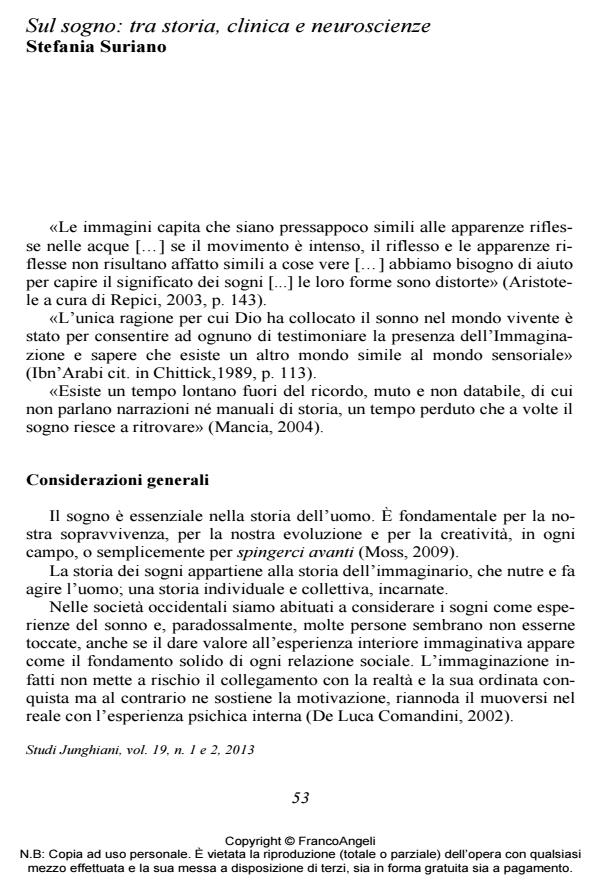On dreaming: between history, clinic experience and neurosciences
Journal title STUDI JUNGHIANI
Author/s Stefania Suriano
Publishing Year 2014 Issue 2013/37-38
Language Italian Pages 27 P. 53-79 File size 788 KB
DOI 10.3280/JUN2013-037004
DOI is like a bar code for intellectual property: to have more infomation
click here
Below, you can see the article first page
If you want to buy this article in PDF format, you can do it, following the instructions to buy download credits

FrancoAngeli is member of Publishers International Linking Association, Inc (PILA), a not-for-profit association which run the CrossRef service enabling links to and from online scholarly content.
The history of psychoanalysis is inextricably linked to the study of dream. In man’s history, dream connects opposites worlds: waking and sleep, unconscious and consciousness, reason and desire. Important in ancient time, dream was forgotten in the rationalistic West society in nineteenth century and then revalued by the psychoanalysis as a way to the unconscious, in according to a depth psychology which rejects idea that a rational consciousness is the only guide of behaviour. Freud translated the figurative language of the dream in the wakefulness language with the interpretation, a unidirectional idea of therapy, based on the progressive conquest of the id by the ego. Jung thought that the dream work is part of the natural need of a more broad and balanced conscience, as well as part of a process based on a continuous dialogue between conscious and unconscious, that can be represented as a cyclic spiral structure. In accordance with Freud, dream images are signs corresponding to concepts. With Jung is possible to say that dream images are symbols. Circumambulation and Amplification consent a dialogue between wake and dream states, in a mutual emotional relationship, making it possible to link potential disjoint self-states, without a voice, not heard, often outcome of traumatic, dissociative experiences. The clinic case describes the mutual construction process of the symbolic meaning of the dream. In Jungian theory and technique images are the focus of the work. The Jung’s insights of psychological functioning as internal perception of images representing the body’s processes, lead to the conclusion that a distinction (between the body and psyche) is an intellectual process undertaken in order to acquire knowledge the same event in two visuals. A very current idea, confirmed by neuroscience, so that in the twenty-first century medicine, imaginal healing is becoming a crucial rôle in a new approach to health, which is characterized by the narrative healing and dreams power.
Keywords: Dream, unconscious, image, circumambulate, amplification, neuroscience
Stefania Suriano, Sul sogno: tra storia, clinica e neuroscienze in "STUDI JUNGHIANI" 37-38/2013, pp 53-79, DOI: 10.3280/JUN2013-037004